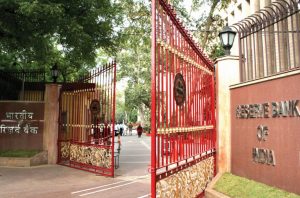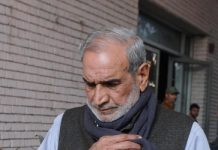 For quite a while, reports have been circulating in the public space that the Government was planning to invoke Section 7 of the Reserve Bank of India Act to ask the central bank to hand over a part of its surplus reserves to put that to more productive use. The matter is pending before the Board of the RBI and is likely to be taken up again at its next meeting likely on November 19.
For quite a while, reports have been circulating in the public space that the Government was planning to invoke Section 7 of the Reserve Bank of India Act to ask the central bank to hand over a part of its surplus reserves to put that to more productive use. The matter is pending before the Board of the RBI and is likely to be taken up again at its next meeting likely on November 19.
Subhash Chandra Garg, Secretary of the Department of Economic Affairs, tweeted:“[A] lot of misinformed speculation is going around in media. The government’s fiscal math is completely on track. There is no proposal to ask RBI to transfer 3.6 or 1 lakh crore, as speculated.” Confident of meeting fiscal deficit target, the government on November 9 clarified it is not seeking transfer of 3.6 lakh crore reserves from the RBI and the only proposal under discussion is to fix appropriate economic capital framework of the central bank. On the fiscal road map, he said, the government will stick to the fiscal deficit target of 3.3 per cent for the current financial year.
“Government’s FD (fiscal deficit) in FY 2013-14 was 5.1 per cent. From 2014-15 onwards, Government has succeeded in bringing it down substantially. We will end the FY 2018-19 with FD of 3.3 per cent. Government has actually foregone 70,000 crore of budgeted market borrowing this year,” he said. Garg further said the only proposal “under discussion is to fix appropriate economic capital framework of RBI”. The clarification came amidst report that the government is seeking transfer of at least a third of Reserve Bank’s 9.6 lakh crore reserves. Besides, it has also been pointed out that the government wants the RBI to part with most of its profit as dividend.
November 19 meeting
Government officials opine that “currently, the RBI’s capital needs put its provisioning at 27 per cent, while most central banks have theirs at 14 per cent. Our calculations state that if RBI provisions at 14 per cent, it can free up to 3.6 lakh crore,” the official said. The RBI board is likely to discuss capital framework and other issues at its meeting scheduled to be held on November 19.
The government’s demand is expected to further fuel tensions with the RBI, which has been pushing back any moves that curtail the central bank’s independence. Part of the reason for the acrimony was the leak of hostile communication shared between the RBI and the Finance Ministry. Deputy Governor of the RBI Viral Acharya went on to point out that any attempt by the union government to cross the red lines would come at a cost. The veiled reference was against the use Section 7 of the RBI Act 1934 which allows the union government to override the central bank.
The government view point seems that most central banks around the world keep 13 per cent to 14 per cent of their assets as reserve, compared with the Reserve Bank’s 27 per cent. An indication about things to come up was available in the Economic Surveys which suggested that the RBI was sitting on too much capital. Last year, the RBI parted with 10,000 crore more as interim dividend which had been opposed by Governor Urjit Patel.
The government also wants the RBI to be lenient with capital adequacy norms, the official said, adding those norms for lenders are very stringent compared with global standards. The liquidity squeeze in non-banking finance companies could have a spiral effect and impact growth if not addressed immediately. The government also wants some of these strictures to be eased so that banks can kick start lending and support economic growth ahead of a general election early next year.
Is RBI too strict?
One of the criticisms the Reserve Bank of India has faced lately is that it’s being too stringent in applying the prompt corrective action framework for banks. This situation seems extremely serious, sensitive and delicate issue which will have very-very severe implications on the economic sovereignty of India. This was something which would have been absolutely unprecedented, never ever in the history of the Reserve Bank of India ever since it came in to existence has Section 7 been ever invoked or directions been given by the Central Government and any Central Government to the Central Bank i.e. the Reserve Bank of India.
When speculations mounted Government in its usual secretive way, came out with a statement which concealed more than it revealed. One was wondering as to what is this entire crisis between the Reserve Bank of India and the Government is all about? Now it seems the fact which are emerging in the public space that the Government wants the RBI to part with 3.6 lakh crore out of the 9.59 lakh crore which constitute the cash reserve of the Reserve Bank of India. So it is one third of the cash reserves of the Reserve Bank of India the Government wants that they should be transferred to the Central Government. And this is going to have profound implications on the macro-economic stability of India.
The autonomy of the Central Bank — the Reserve Bank of India — is what provides confidence to both foreign and Indian investors with regard to the stability of the Indian economy. It constitutes one of the fundamentals, when we say that the fundamentals of the Indian economy are strong, this is one of the fundamentals of the Indian economy that the Reserve Bank of India has enough liquidity available in order to meet any contingency.
It had very serious consequences wherever such a move was undertaken. For instance, in Argentina when $6.6 billion was transferred by the Central Bank to the National Treasury, it sparked of one of the worst constitutional crisis and Argentina is before the International Monetary Fund for a $50 billion bailout — $50 billion bailout and the Argentine currency has completely gone haywire.
Economic Survey indicators
Why playing with the economic sovereignty of India? The reasons are available in the economic data which is put out by the Ministry of Finance. The fiscal deficit and the Current Account Deficit is mounting on a daily basis. In the first quarter of 2018-19, it was at $15.8 billion which is almost 2.4 per cent of the GDP and it is growing. Government revenues are not growing in a corresponding manner because the economy has shrunk. In order to bridge that fiscal deficit, the Government has started eyeing the money which is lying with the Reserve Bank of India.
Far from achieving a desirable ‘monetary-fiscal coordination’ in India today, the Reserve Bank of India and the government give the impression that they are not on the same page even as far as an understanding of their roles is concerned. The RBI suggests that its independence is being violated while the government rationalises its intervention in terms of its concern for the economy.
letters@tehelka.com













